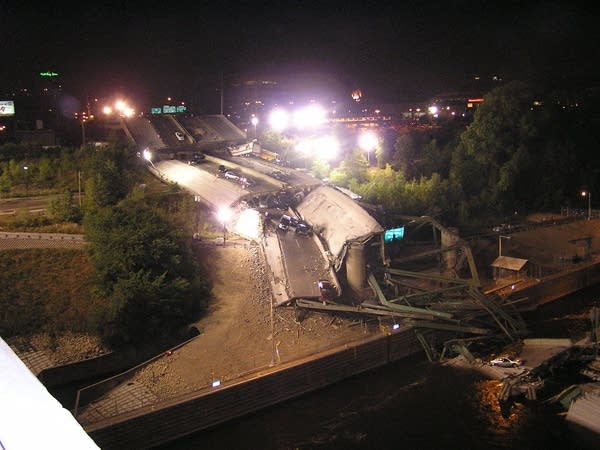Perspective from a first responder

Curt Mackey, real estate appraiser by day and assistant chief of the Hopkins fire department at night, was on site in the early hours of the I-35W bridge collapse rescue and recovery effort.
MPR's Michael Caputo: What can you recall of the experience?
Firefighter Curt Mackey: The pictures are implanted in my brain. It has been hard to focus on anything else since being down there for such a long time, going over the pictures and imagining the people that were victims. And how some people survived and some people didn't have a chance. That graphic picture itself always gets stamped into your brain for quite a few days. And after 11 years in the business, this is obviously the biggest call that we've had to address. We are a chemical assessment team. We work for the state of Minnesota. We went down and assessed rail cars that were underneath the bridge in a real unstable area, basically determining whether there are any life-safety issues with the products inside the tanks, which were leaking. We were on standby for air monitoring and air tests to do quality control for the responders to make sure they were protected. By and large it was overwhelming to see the bridge go down at once. When a part of a light weight truck fails, the whole truck fails and it looked like something similar happened to the bridge. Every component of the bridge depends on every other part of the bridge. If one component fails, it all fails and obviously that is what happened. Looking back as a responder, we're just scratching our heads wondering why anyone would build a bridge with that sort of interdependency. We were informed that is was mainly for the barge traffic.

MPR: There was a train underneath? Was everything ok with it?
Create a More Connected Minnesota
MPR News is your trusted resource for the news you need. With your support, MPR News brings accessible, courageous journalism and authentic conversation to everyone - free of paywalls and barriers. Your gift makes a difference.
Mackey: Yes, there is no life-threatening situation now. They know how to treat it. There is a possibility of it becoming volatile but they know how to treat it. That should be getting cleaned up today.
MPR: What was the chemical?
Mackey: They won't let us divulge that. What we have in the field are high-tech sensors and we took samples and read them. But until they go to a higher level of testing they won't allow us to divulge the product.
MPR: Talk more about the bridge interdependency. Is the bridge unique?
Mackey: I would imagine that they use that technique a lot because it does meet standards. This situation will probably change the standards of bridge design. After talking to some of the bridge construction workers that were on scene, they obviously felt that it was the north side of the bridge that gave way early on and then the rest of it came down in the south. If you look at the wreckage, you can see that they south side of the bridge came down much slower. And some of the orange barrier cones that were props there are still in place. That was probably based on weight alone, it just fell down. It didn't pull apart and crash down. The north side is just shearer, a break and it would lead you to believe the north side went more quickly and just gave way and the rest of it was a result of that.

MPR: Was there any feeling among the construction workers that there was too much work being done on the bridge? Did it have anything with what they were doing?
Mackey: They really didn't think so. They were doing routine surface work; they weren't addressing the structural integrity of the bridge whatsoever. They didn't have any excessive weight on the bridge. In fact there was less weight on the bridge because of reduced traffic. They had four lanes out of eight shut down during rush hour. They were really surprised and in shock with what was going on. I know that they lost a lot of their co-workers and this has been really hard on them. It's hard for them to talk about it or be on the scene, knowing that some guys were out there on the eastern lane working on taking up some of the cement and exposing the rebar. Those two lanes just dropped right in. They know that they've lost a lot of workers because they don't know how many workers haven't been recovered, haven't checked in. They're trying to figure out who went home safely or if they are still around.
MPR: That must be gut-wrenching.
Mackey: It is a massive, massive failure. And 60+ feet down we were working off the 10th street bridge and it is hard to imagine being in that situation. That some people survived really is a miracle. Some of the people survived after their vehicles were landed on, flipped over. Imagine taking a 60 foot drop in your vehicle and being landed on by another one.
MPR: Just looking at the wreckage is gruesome. What were you thinking as you took the photographs?
Mackey: I figured that I was never going to see something like this again. Hopefully the photos will help the future development. That is the thing that stuck out for us as first responders: why are we here today doing what we have to do? If there is any way that we could help avoid future tragedies like this anywhere else, hopefully the photos will open up people's eyes to better structural design and stricter inspections requirements on spanning bridges that don't have a lot of support underneath.
